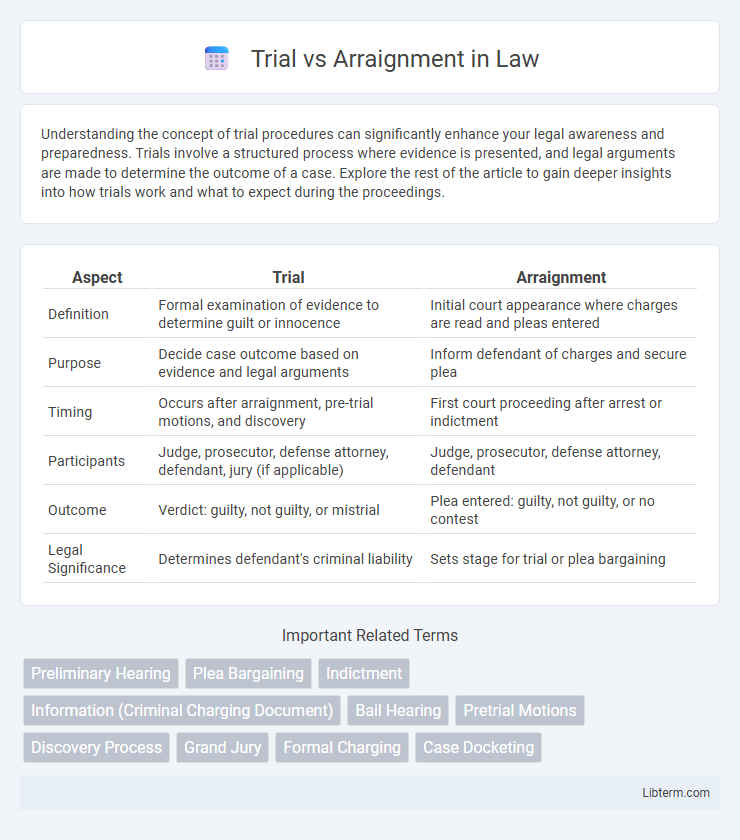Understanding the concept of trial procedures can significantly enhance your legal awareness and preparedness. Trials involve a structured process where evidence is presented, and legal arguments are made to determine the outcome of a case. Explore the rest of the article to gain deeper insights into how trials work and what to expect during the proceedings.
Table of Comparison
| Aspect | Trial | Arraignment |
|---|---|---|
| Definition | Formal examination of evidence to determine guilt or innocence | Initial court appearance where charges are read and pleas entered |
| Purpose | Decide case outcome based on evidence and legal arguments | Inform defendant of charges and secure plea |
| Timing | Occurs after arraignment, pre-trial motions, and discovery | First court proceeding after arrest or indictment |
| Participants | Judge, prosecutor, defense attorney, defendant, jury (if applicable) | Judge, prosecutor, defense attorney, defendant |
| Outcome | Verdict: guilty, not guilty, or mistrial | Plea entered: guilty, not guilty, or no contest |
| Legal Significance | Determines defendant's criminal liability | Sets stage for trial or plea bargaining |
Introduction to Trial and Arraignment
Arraignment is the initial court proceeding where the defendant is formally charged, informed of their rights, and asked to enter a plea. The trial is a subsequent phase where evidence is presented before a judge or jury to determine the defendant's guilt or innocence. Understanding the distinct roles of arraignment and trial is essential for navigating the criminal justice process effectively.
Definition of Arraignment
Arraignment is the formal court proceeding in which a defendant is officially charged with a crime and informed of their rights. During arraignment, the defendant enters a plea of guilty, not guilty, or no contest, setting the stage for future legal steps. This process differs from a trial, where evidence is presented, and verdicts are determined.
Definition of Trial
A trial is a formal judicial examination where evidence is presented, and legal arguments are made to determine the guilt or innocence of a defendant. It typically involves witnesses, juries, and a judge who evaluates the facts to deliver a verdict. Unlike an arraignment, which is a preliminary hearing to hear charges and enter pleas, a trial resolves the substantive issues of the case.
Key Differences Between Trial and Arraignment
Trial and arraignment are distinct phases in the criminal justice process, with key differences in purpose and procedure. Arraignment occurs early, where the defendant is formally charged and enters a plea, while trial is the later stage involving examination of evidence and determination of guilt. The arraignment focuses on procedural rights and plea options, whereas the trial centers on factual evaluation and verdict delivery.
Legal Process: Arraignment Steps
The arraignment is the initial step in the legal process where the defendant is formally presented with the charges and asked to enter a plea. During the arraignment, the judge informs the defendant of their rights, and bail conditions may be set or reviewed. This procedure ensures the defendant understands the accusations and sets the stage for subsequent pretrial motions or trial scheduling.
Legal Process: Trial Procedures
Trial procedures in the legal process involve the formal examination of evidence and witness testimonies before a judge or jury to determine the guilt or innocence of the defendant. Unlike arraignment, where charges are read and pleas entered, a trial includes opening statements, witness examinations, presentation of evidence, closing arguments, and jury deliberation. This phase ensures that due process is upheld, allowing the defense and prosecution to present their cases under courtroom rules and legal standards.
Rights of the Defendant at Arraignment
At arraignment, the defendant's rights include being informed of the charges, the right to legal counsel, and the opportunity to enter a plea. The court ensures the defendant understands their rights, including the right to remain silent and the right to a speedy trial. These protections establish the foundation for due process before proceeding to trial.
Rights of the Defendant at Trial
The rights of the defendant at trial include the right to a fair and public hearing by an impartial jury, the right to confront and cross-examine witnesses, and the right to present evidence and call witnesses in their defense. Defendants also have the right to be informed of the charges against them, the right to legal counsel, and the protection against self-incrimination under the Fifth Amendment. These rights ensure due process and protect the defendant from wrongful conviction during the trial phase, contrasting with the arraignment stage where the focus is on formal charge notification and bail determination.
Outcomes of Arraignment vs. Trial
Arraignment outcomes primarily determine whether a defendant enters a plea of guilty, not guilty, or no contest, setting the stage for the next phase of the criminal process. Trial outcomes involve a verdict of guilty or not guilty, directly impacting sentencing, fines, or acquittal. While arraignment influences case trajectory and potential plea agreements, trial results have definitive legal consequences on the accused's criminal record and liberty.
Importance of Understanding Both Stages in Criminal Justice
Understanding the distinction between trial and arraignment is crucial in criminal justice as the arraignment establishes the defendant's formal charges and plea, setting the stage for trial procedures. The trial serves as the fact-finding process where evidence is presented and legal arguments determine guilt or innocence. Mastery of both stages ensures procedural rights are upheld and informs effective defense strategies throughout the criminal process.
Trial Infographic

 libterm.com
libterm.com